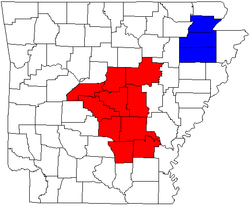Arkansas metropolitan areas

| Part of a series on |
| Regions of Arkansas |
|---|
 |
|
Geographic Regions |
|
Administrative divisions
|
The State of Arkansas has a total of eight metropolitan statistical areas (MSAs) that are fully or partially located in the state. Twenty of the state's 75 counties are classified by the United States Census Bureau as metropolitan.
Among these is one of the fastest growing MSAs in the United States, Fayetteville Springdale-Rogers.[1]
Metropolitan areas
- Little Rock-North Little Rock-Conway MSA — includes Faulkner County, Grant County, Lonoke County, Perry County, Pulaski County, and Saline County.
- Fayetteville-Springdale-Rogers MSA — includes Benton County, Madison County, and Washington County (other counties of the metropolitan area are located in the state of Missouri).
- Fort Smith MSA — includes Crawford County, Franklin County, and Sebastian County (other counties of the metropolitan area are located in the state of Oklahoma).
- Texarkana MSA — includes Miller County (other counties of the metropolitan area are located in the state of Texas).
- Jonesboro MSA — includes Craighead County, and Poinsett County.
- Pine Bluff MSA — includes Cleveland County, Jefferson County, and Lincoln County.
- Hot Springs MSA — includes Garland County.
- Memphis MSA — includes Crittenden County (other counties of the metropolitan area are located in the states of Tennessee and Mississippi).
Population statistics
The following table lists population figures for these metropolitan areas, in rank of population. Population figures are for the 2014 U.S. Census.
| Rank | Metropolitan Area | Population |
|---|---|---|
| 1 | Little Rock-North Little Rock-Conway, AR | 729,135 |
| 2 | Fayetteville-Springdale-Rogers, AR-MO | 501,563 |
| 3 | Fort Smith, AR-OK | 279,592 |
| 4 | Texarkana, AR-TX | 149,235 |
| 5 | Jonesboro, AR | 126,764 |
| 6 | Pine Bluff, AR | 94,716 |
| 7 | Hot Springs, AR | 97,322 |
| 8 | West Memphis, TN-MS-AR | 1,341,746 |
Combined Statistical Areas

There are three combined statistical areas (CSAs) in the state. The Little Rock-North Little Rock, AR Combined Statistical Area includes the Little Rock and Pine Bluff metropolitan areas and the Searcy micropolitan area. The Jonesboro-Paragould combined statistical area was created by the Census Bureau in 2005 and includes the Jonesboro metropolitan area and Paragould micropolitan area. The Hot Springs-Malvern Combined statistical area was created in 2013 which includes the Hot Springs metropolitan area and the Malvern micropolitan area.
Population statistics
The three Combined Statistical Areas in the state are listed in the table below with their populations from the 2014 census.
| Rank | Combined Statistical Area | Population |
|---|---|---|
| 1 | Little Rock-North Little Rock | 902,443 |
| 2 | Jonesboro-Paragould | 170,458 |
| 3 | Hot Springs-Malvern | 130,690 |
References
- ↑ "Economic Growth with Limited Agglomeration Economies" (PDF). University of Arkansas. Retrieved Aug 18, 2012.